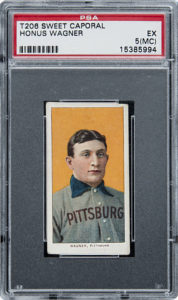My nephew collected baseball cards as a kid. His father was an avid collector of various items such watch fobs, and Greg aspired to an equivalent seriousness. He got a guidebook about the value of individual cards and kept abreast of the value of each card in his collection. He came to me once, proudly showing a card. “Look at this!” he bragged. “This card is worth eight dollars!”
He was so proud of his possession that I didn’t have the heart to ask him, “Greg, do you know anyone who will actually put eight dollars into your hand in exchange for this card? Because if you don’t, it’s not worth eight dollars.”
The same warning applies to any baseball card, even the “Holy Grail” of them all, the card of Honus Wagner which was included in packs of Sweet Caporal cigarettes from 1909-11. (Baseball cards came with cigarettes, not bubble gum, back then.)
A mint-condition copy of this card, less than three inches high, sold in a sports memorabilia auction last year for $3,120,000. Even copies in less than perfect condition bring big money. And yet, remove the card from its protective holder, take it to the mall in your town, hand it to the counter person at McDonald’s, and ask him to give you a Big Mac in exchange. Unless the counter person is extremely knowledgeable about old baseball cards, my guess is that you’ll leave hungry.
In the same way, works of art derive their monetary value from the passions (and the income) of the people who collect them. When there is a large pool of collectors who are passionate about the art of a particular period and place, the market will rise. When there is a smaller pool of collectors for that art, unless a few of them are extremely well-heeled and masterpieces are few, the market will be soft.
I have written in previous blogs about how hot the market for contemporary art currently is and about the volatility of its swings, as young artists cycle in and out of fashion. I have also written about the current relative lack of favor for American 19th century genre and still life paintings. There are fine pieces out there, and since there aren’t as many collectors in the field as there were a quarter century ago, first-rate works are still available at a relative discount to those with the eyes to see them.
Antiques Roadshow stories to the contrary, though, such works are rarely found at flea markets. I was reading a piece about the Old Master market the other day and was struck by a comment from dealer Richard Feigen: “It’s a big mistake for people to hunt for hidden bargains. The chances of something slipping through are very small, and the number of experts out there is considerable. I think the real bargains are things that are fully recognized for what they are in areas that are very neglected.”
I would be happy to help you explore neglected markets. Let’s talk soon.

